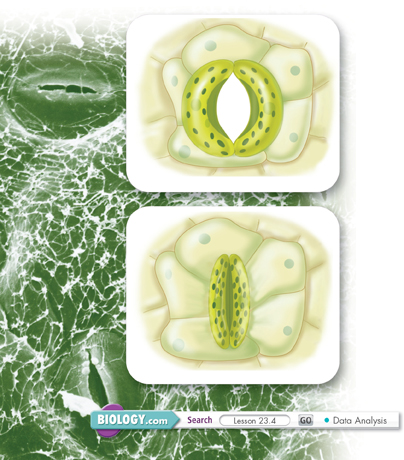Gas Exchange and Homeostasis
 What role do stomata play in maintaining homeostasis?
What role do stomata play in maintaining homeostasis?
You might not think of plants as “breathing” the same way that animals do, but plants need to exchange gases with the atmosphere, too. Plants, in fact, can even be suffocated by lack of oxygen, something that often happens during extensive flooding. A plant's control of gas exchange is actually one of the most important elements of homeostasis for these remarkable organisms.
Gas Exchange Leaves take in carbon dioxide and give off oxygen during photosynthesis. When plant cells use the food they make, the cells respire, taking in oxygen and giving off carbon dioxide (just as animals do). Plant leaves allow gas exchange between air spaces in the spongy mesophyll and the exterior by opening their stomata.
Homeostasis It might seem that stomata should be open all the time, allowing gas exchange to take place and photosynthesis to occur at top speed. However, this is not what happens! If stomata were kept open all the time, water loss due to transpiration would be so great that few plants would be able to take in enough water to survive. So, plants maintain a kind of balance.  Plants maintain homeostasis by keeping their stomata open just enough to allow photosynthesis to take place but not so much that they lose an excessive amount of water.
Plants maintain homeostasis by keeping their stomata open just enough to allow photosynthesis to take place but not so much that they lose an excessive amount of water.

FIGURE 23–16 How Guard Cells Function Plants regulate the opening and closing of their stomata to balance water loss with rates of photosynthesis. The photo shows two partly open stomata on the underside of a camellia leaf (SEM 1500X). Observe How is the structure of guard cells related to their function?
Guard cells in the epidermis of each leaf are the key to this balancing act. Guard cells are highly specialized cells that surround the stomata and control their opening and closing. Guard cells regulate the movement of gases, especially water vapor and carbon dioxide, into and out of leaf tissues.
The stomata open and close in response to changes in water pressure within the guard cells, as shown in Figure 23–16. When water is abundant, it flows into the leaf, raising water pressure in the guard cells, which then open the stomata. The thin outer walls of the cells are forced into a curved shape, which pulls the thick inner walls of the guard cells away from one another, opening the stoma. Carbon dioxide can then enter through the stoma, and water is lost by transpiration.
When water is scarce, the opposite occurs. Water pressure within the guard cells decreases, the inner walls pull together, and the stoma closes. This reduces further water loss by limiting transpiration.
Table of Contents
- Formulas and Equations
- Applying Formulas and Equations
- Mean, Median, and Mode
- Estimation
- Using Measurements in Calculations
- Effects of Measurement Errors
- Accuracy
- Precision
- Comparing Accuracy and Precision
- Significant Figures
- Calculating With Significant Figures
- Scientific Notation
- Calculating With Scientific Notation
- Dimensional Analysis
- Applying Dimensional Analysis




